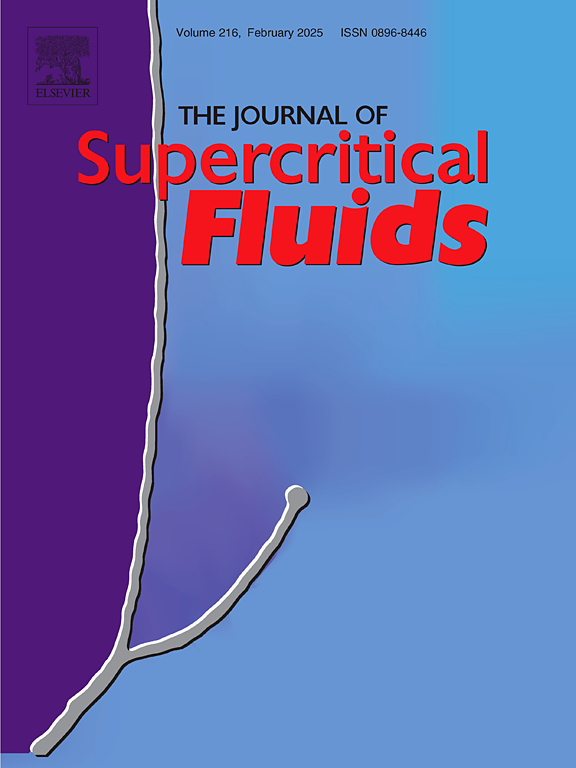溶剂选择和 RESS 处理条件对在超临界二氧化碳中形成吡喹酮-丙二酸共晶体的影响
IF 3.4
3区 工程技术
Q2 CHEMISTRY, PHYSICAL
引用次数: 0
摘要
吡喹酮 (PZQ) 是一种溶解度较低的抗蠕虫药物,因此需要通过共晶体化和缩小粒度来提高生物利用度。本研究采用超临界溶液快速膨胀法(RESS)对 PZQ-丙二酸共晶体进行了微粉化。由于 PZQ 在 scCO2 中的溶解度较低,因此筛选了四种共溶剂作为 RESS 改性剂。加入丙酮或四氢呋喃会产生 PZQ 及其共晶体的混合物,而加入 MeOH 和 EtOH 则会产生纯共晶体。研究了压力(15-30 兆帕)、温度(35-55 °C)和共溶剂添加量(3-10 体积)对相纯度、产量和粒度的影响。在 RESS 中添加共溶剂可促进共晶体形成剂在 scCO2 中的溶解和共晶体的结晶,其产率高达 68.5 wt%,粒度低至 600 nm。结果表明,对于在 scCO2 中溶解度较低的原料药,共溶剂改性 RESS 是一种同时结晶和微粉化的合适方法。本文章由计算机程序翻译,如有差异,请以英文原文为准。
Influence of solvent selection and RESS processing conditions on formation of a praziquantel-malonic acid cocrystal in supercritical CO2
Praziquantel (PZQ) is an anthelmintic drug with low solubility, therefore cocrystallization and particle size reduction is desirable to improve bioavailability. In this study, a PZQ-malonic acid cocrystal was micronized by rapid expansion of supercritical solution (RESS). Due to low solubility in scCO2, four cosolvents were screened as RESS modifiers. While addition of acetone or THF yielded mixtures of PZQ and its cocrystal, MeOH and EtOH produced pure cocrystal. Impact of pressure (15–30 MPa), temperature (35–55 °C), and cosolvent loading (3–10 volumes) on phase-purity, yield, and particle size were investigated. Adding cosolvent to RESS facilitated dissolution of cocrystal formers in scCO2 and crystallization of the cocrystal with yields up to 68.5 wt% and particle size as low as 600 nm. Results show that for APIs with low solubility in scCO2, cosolvent-modified RESS is a suitable approach for simultaneous crystallization and micronization.
求助全文
通过发布文献求助,成功后即可免费获取论文全文。
去求助
来源期刊

Journal of Supercritical Fluids
工程技术-工程:化工
CiteScore
7.60
自引率
10.30%
发文量
236
审稿时长
56 days
期刊介绍:
The Journal of Supercritical Fluids is an international journal devoted to the fundamental and applied aspects of supercritical fluids and processes. Its aim is to provide a focused platform for academic and industrial researchers to report their findings and to have ready access to the advances in this rapidly growing field. Its coverage is multidisciplinary and includes both basic and applied topics.
Thermodynamics and phase equilibria, reaction kinetics and rate processes, thermal and transport properties, and all topics related to processing such as separations (extraction, fractionation, purification, chromatography) nucleation and impregnation are within the scope. Accounts of specific engineering applications such as those encountered in food, fuel, natural products, minerals, pharmaceuticals and polymer industries are included. Topics related to high pressure equipment design, analytical techniques, sensors, and process control methodologies are also within the scope of the journal.
 求助内容:
求助内容: 应助结果提醒方式:
应助结果提醒方式:


